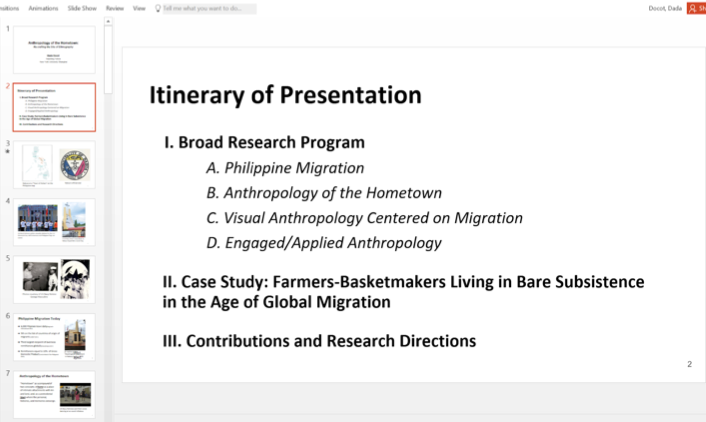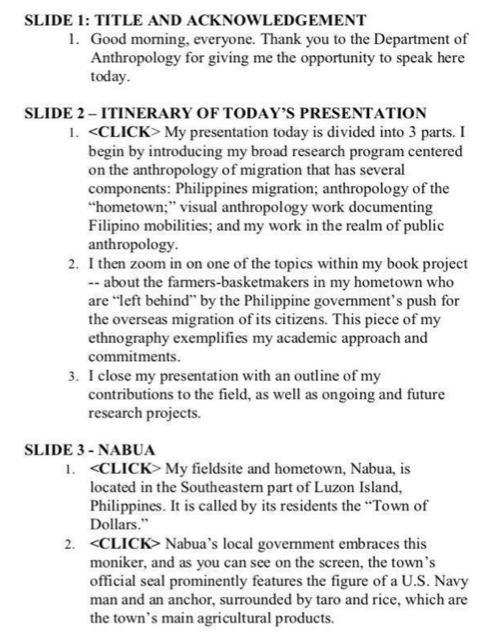You have /5 articles left.
Sign up for a free account or log in.
Demystification is an anthropological preoccupation. In this essay, I will unpack an activity in academe that seems elusive yet noteworthy: the campus job visit. I look back on my experience in January 2019 in the department of anthropology at Purdue University as a reference. In doing so, I intend to suggest tools to help you navigate the process strategically. I write as a first-generation Filipina college and graduate degree holder who finds preparedness useful for mitigating nervousness and uncertainty, especially when venturing into confounding academic rites of passage.
I elaborate below on some elements of my campus visit -- which turned out to be a successful one -- that I hope you might find useful.
Job talk poster. The inviting department asked for my talk’s title, its abstract and my photograph for a job talk poster. The department planned to circulate the poster internally, and I thought that there was no more revising after I had sent to them. I was fortunate to have had a professional photograph taken at New York University Shanghai, the institution where I held a two-year fellowship at the time of my application.
The first real task that I faced was to look for a striking title, and through conversations with Christina Sornito Carter, assistant professor in anthropology at Appalachian State University, it improved from “Bare Subsistence in the Town of Dollars, Philippines” to “Anthropology of the Hometown: Recrafting the Site of Ethnography.”
The next task was to draft the abstract. To ensure that I was making the right decision about the content and direction of my talk, I asked my mentors to help me identify the strongest portion of my doctoral work. I initially thought of focusing on methods, but they advised me otherwise. My mentors said that I should highlight the broad scope of my work including research, community engagement and future plans. Thus, I came up with the final outline of my presentation, as shown below.

The script. I was told to prepare a 45-minute “research talk.” I debated with myself whether I should write a full speech or just write down talking points. As a nonnative speaker of English with stage fright, talking extemporaneously to an audience of mostly native English speakers worried me. Martin F. Manalansan IV, associate professor of anthropology and Asian American Studies at the University of Illinois at Urbana-Champaign and one of my mentors, with whom I had exchanged many messages during the application season, said that reading off a script is a common practice in job talks, or at least in anthropology. His advice eased my tension about public speaking.
Years of presenting at conferences have taught me that an uninterrupted flow of text on paper can be confusing to tired eyes, so I formatted the script of my speech legibly. It contained slide numbers, and each thought was itemized. I added prompts to click the next slide and dog-eared each page at the bottom to ease flipping to the next page:

Practice. I practiced my talk twice with colleagues at NYU Shanghai. They acted as mock members of the search committee and conducted a 30-minute Q&A after my presentation. After the Q&A, they gave suggestions on how the script could be improved.
I then videotaped and timed my presentation. I also practiced with my partner twice via WebEx, and again with my colleague Asligul Berktay, another teaching fellow at NYU Shanghai. With practice and fine-tuning, the content and delivery of my speech gradually and notably improved. It is worth repeating the same advice I’ve received from peers: “Practice, practice, practice.”
Schedule of activities. Ten days before my campus visit, the inviting department emailed me the schedule of my four-night stay. The main events included my talk on the second day and a closed-door interview on the third. Aside from those, the schedule included meetings with graduate students and selected faculty, a real estate tour, and a visit to a cultural center that I had expressed interest in.
Using the schedule, I did an online search of the people I would be meeting, printed one article for each and read their works carefully. I had a pocket-size notebook -- my “field notes” -- for taking down notes on each person’s profile and scholarship. I also had a dedicated page for writing: 1) their name, position, department, where Ph.D. was obtained, research interest, 2) key concepts and quotes from their work, and, finally, 3) their contributions to the field and how our interests intersect. I also visited their websites and learned about their community engagement.
Professional attire. I do not buy new clothes unless absolutely needed, as my own small practice in response to climate change. Growing up, I was also used to wearing hand-me-downs from my elder sisters and aunts. But for the day of the job talk, I decided to buy a new winter dress and a pair of warm shoes with decent traction. However, I still needed an outfit for the closed-door interview. I chatted with friends who helped me choose the best combination from a selection of hand-me-downs.
Scholars of color often feel the pressure to exert extra effort to look “professional” and “professorial.” Kristie A. Ford writes about the climate of misrecognition and marginalization of women of color in the academy. Homa Hoodfar suggests a critical feminist pedagogy within academic environments that often exclude marginalized experiences and voices.
Scholars of color are also burdened with performing the role of authority and expertise. “Mask-wearing” and “blending in” are methods often lauded in ethnography. However, I did not want to wear a professional mask and see a stranger in the mirror. So I decided to carry my preloved backpack that I bought from a fellow Filipino in Shanghai. In it, I put my schedule, field notes, application dossier, sample syllabi, a water bottle and candies and the energy bars from my welcome goodie bag. I also included a sheet with the names and research interests of the search committee and talking points with them about how their research intersects with mine. I decided that “looking professional” would not be my top concern.
Preparing for the unexpected. I have also read that bathroom breaks are the only moments of rest candidates are given. That is true. I recommend that you take bathroom breaks whenever possible. During those breaks, I reviewed my field notes.
I should also mention that I was not able to wear my planned closed-door interview outfit because I was worried about the phenomenally low temperatures wrought by the polar vortex. I showed up on the day of the closed-door interview wearing a dark-green blazer paired with two layers of yoga pants and a decent winter dress coat that I scored from an aunt’s closet some years ago.
As I mentioned at the beginning of this essay, I see preparedness as a useful skill. In Manila, I grew up struggling to excel within conditions that were not always the most ideal. Financial hurdles were constant, but our extended family’s and friends’ generosity was always forthcoming. Moving back to my hometown south of the capital for secondary education, I learned of how people in my hometown take the pre-emptive approach to life due to the tropical typhoons and persistent flooding that could occur anytime. I have taken these lessons, not only about generosity but also about caution, alertness and vigilance, with me as I traveled out of the Philippines and on to Japan and Canada in pursuit of advanced degrees -- and also to China and the U.S. for work.
I hope that the tips that I have shared here today are useful to you if you are preparing for a campus job visit. More recommendations are coming next week.







